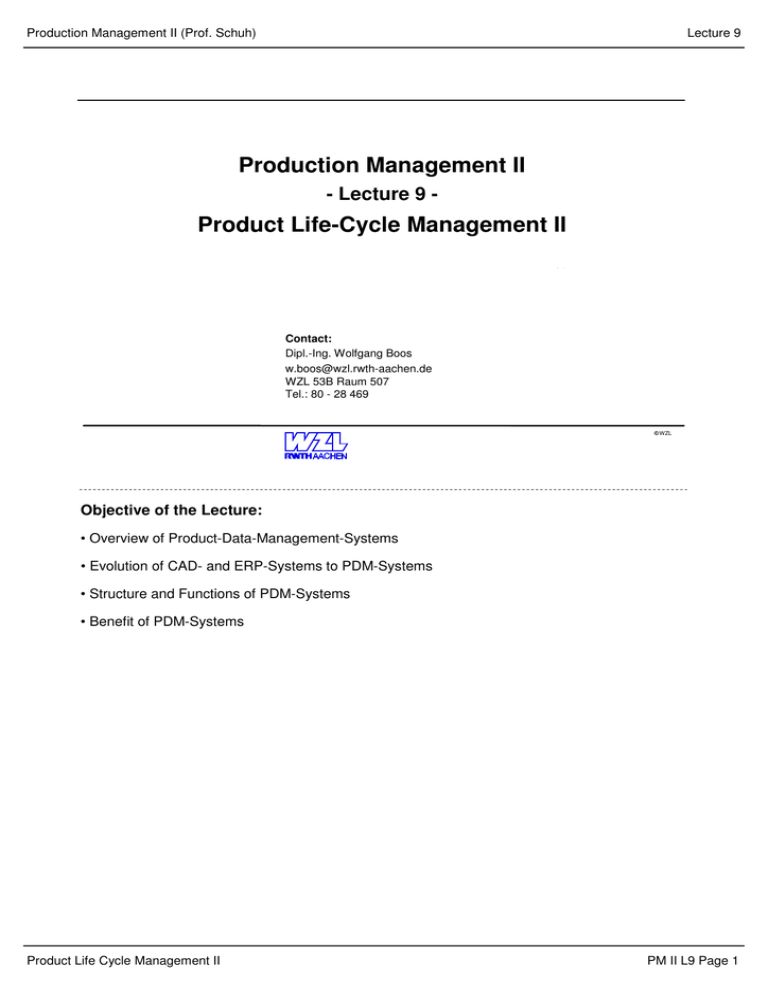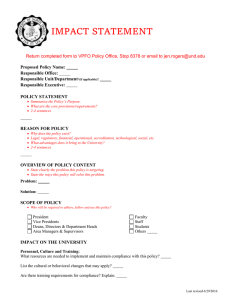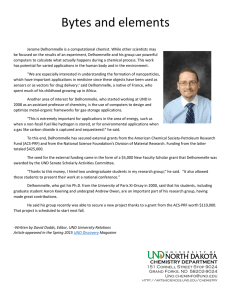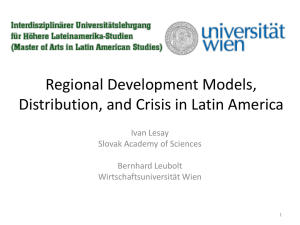Production Management II Product Life-Cycle Management II
advertisement

Production Management II (Prof. Schuh) Lecture 9 Production Management II - Lecture 9 - Product Life-Cycle Management II Contact: Dipl.-Ing. Wolfgang Boos w.boos@wzl.rwth-aachen.de WZL 53B Raum 507 Tel.: 80 - 28 469 © WZL Objective of the Lecture: • Overview of Product-Data-Management-Systems • Evolution of CAD- and ERP-Systems to PDM-Systems • Structure and Functions of PDM-Systems • Benefit of PDM-Systems Product Life Cycle Management II PM II L9 Page 1 Production Management II (Prof. Schuh) Lecture 9 IT-Systems in the field of Production Management Market Engineering Process Engineering Production Planning Manufacturing Assembly CAD Distribution Service Maintenance Disassembly Recycling CRM CAM SCM CAP ERP CAQ CAE CAO PLM-Meta-Data Pool (Links of Product Data) CAD: Computer Aided Design CAE: Computer Aided Engineering CAM: Computer Aided Manufacturing CAO: Computer Aided Office CAQ: Computer Aided Quality CAM: Computer Aided Manufacturing CRM: Custom Relationship Management ERP: Enterprise Ressource Planning PLM: Product Lifecycle Management SCM: Supply Chain Management © WZL The PLM-Meta-Data Pool ist the integration platform of all product data. Meta-Data are datums to identify data material (e.g. date of revision of a drawing). The pool is integrated by links and references to data of CAD, CAE, etc. Product Life Cycle Management II PM II L9 Page 2 Production Management II (Prof. Schuh) Lecture 9 Classification of PLM Definitions PLM = PDM PLM is not a new class of systems and not a new kind of PDM-Systems, but the consequent implementation,based on web-technolgies, of enterprise and location spanned use of PDM-core competencies. Data management, process management and system integration in all fields and phases of the industrial value added. www.pdm-infoshop.de/Schoettner Professor of Chinese Academy of Sciences PLM is the extension of PDM towards a comprehensive Approach for productrelated information and knowledge Management within an enterprise. This includes planning and controlling of processes, that are required for managing data, documents and enterprise resources throughout the entire product lifecycle. PLM systems aredistributed Technological information systems for archieving, administrating and providing all product or facility related information in required quality and at the right time and place IT- oriented approach Management concept PLM is a PDM-System driven by engineering. PLM aides all employees during the complete product-life-cycle by administration of all associated data and processes. PLM is the administration and control of all product data -of the complete life-cycle along the extended logistic chain starting with engineering and manufacturing, over distribution and ending with maintenance. The integrated PLM has access to all product and process data of the whole product life cycle. The range of functions is beyond the described systems. Prof.Dr.Stucky aifb Karlsruhe Ohnemus, T.; in eDM-REPORT Nr.3 2000 Product Data Management (PDM) describes the management and classification of design data and Specifications for an engineered product, and the management of change to this information. PDM is supported by various Product Data Technologies, such as STEP. Product Life-cycle Management (PLM) describes the management and control of all product-related information over the entire product and asset life cycle Pdteurope/ Prof.Dr.Anderl TU Darmstadt PLM is a strategic business approach that applies a consistent set of business solutions in support of the collaborative creation, management, dissemination, and use of product definition information across the extended enterprise from concept to end of life – integrating people, processes, and information-- www.cimdata.com Prof.Dr.M. Abramovici Bochum source: itm © WZL The term of product-life-cycle is used in the literature and by system suppliers in different ways. Three different kinds have to be distinguished: •PLM as a synonym for product data management •PLM as an a integrating platform of different IT-systems •PLM as integrated management concept of data administration and allocation of information Product Life Cycle Management II PM II L9 Page 3 Production Management II (Prof. Schuh) Lecture 9 Evolution und Definition of PLM PLM – horizontal integration 2D-CAD 1960 MRP 1950 Intersection: • adjustment of capacities • configuration • partsadministration • BOMadministration PLM is the administration and control of all product data -during the complete life-cycle along the extended logistic chain - starting with engineering and manufacturing, over distribution and ending with maintenance. The integrated PLM has access to all product and process data of the whole Prof.Dr.Stucky aifb Karlsruhe product life cycle. The range of functions is bigger than the described systems. © WZL In the beginning application software was used to aid isolated activities in the organisation. Examples are 2D-CAD-Systems and MRP (Material Requirement Planning). In the course of integration of activities and the growth of performance of IT-systems additional functions were integrated. The system suppliers have driven the progress further by mergers and strategic collaboration, finally it results in an overlapping of CAD-Systems and ERP-Systems. Product Life Cycle Management II PM II L9 Page 4 Production Management II (Prof. Schuh) Lecture 9 Evolution of PDM-Systems 3rd Generation horizontal integration PDM 2nd Generation vertical integration Life-CycleManagement ERP structuremanagement dokumentenmanagement 1st Generation isolated EDM/PDM-Systeme document management structuremanagement CAD-AddOns: drawing administration, bill of structure characteristics,standard parts,.. 2D/3D-CAD-Systems 1980 1985 1990 1992 1995 2000 Source: itm © WZL Product Life Cycle Management II PM II L9 Page 5 Production Management II (Prof. Schuh) Lecture 9 Terms of Advanced PDM Developments PDM2 = Product and Process Development Management CPC = Collaborative Product Commerce PLM = Product Life Cycle Management cPDM = collaborative Product Data Management VPDM = Virtual Product Definition Management e-PLM = electronic Product Life Cycle Management PDC = Product Definition and Commerce PKM = Product Knowledge Management … Source: itm © WZL The kind of information handling and acquisition that is more sophisticated than today´s functionality of PDM-systems are named differently in the Literature. Examples are: cPDM of CIMdata vPDM of Gartner Group e-PLM of AMR Product Life Cycle Management II PM II L9 Page 6 Production Management II (Prof. Schuh) Lecture 9 Relevance of EDM/PDM-Systemen 3D-CAD high EDM/ PDM VR Future relevance The relevance of EDM/PDM-systems is growing, but there is a lack of control of the systems VR-systems will get more important in the future, but the control of these systems is very low the control of 2D-CADsystems is the highest of all, but the importance will decrease in future middle low 2D-CAD size = grade of control no no low middle high Today´s relevance Source: WZL-Studie 2003 © WZL A study, performed by the WZL, asked 32 different companies about today's and future importance of IT-systems in the field of product engineering. Additional the grade of control of these IT-systems was analysed. Product Life Cycle Management II PM II L9 Page 7 Production Management II (Prof. Schuh) Lecture 9 Structure of Classic PDM-Systems Applicational Functions document/ data management workflow/ process management Utility Functions communication notification product structure management projectmanagement data transport data transformation Viewing/ Redlining classification system administration PDM-Vault product data „meta data“(master data, stucture data, etc,..) Source: itm © WZL PDM-systems have applicational functions, utility functions and the so called PDM-vault. The applicational functions aid directly the activities of user interaction. Utility functions are tasks that are running in in the background layer without any user interaction. The master data is supplied by the PDM-vault. The applications functions refer to product data, the utility functions refer to meta data. Product Life Cycle Management II PM II L9 Page 8 Production Management II (Prof. Schuh) Lecture 9 General Overview of Functions of EDM/PDM-Systems product oriented product structure management document management configuration management classification class lists of characteristics view management revision management file administration storage vaulting process orientiert life-cycle-management process/activity management workflow management project management status management interface management viewing und redlining clearence sequences revision management access authorisation administration auditing communication management history © WZL The functions of EDM/PDM-systems can be divided in two main categories. These are the product oriented and process oriented group of functions. The product oriented functions are used for generation of product data and the administration of product data. The use of process oriented functions is focused on collaboration in- and outside of the enterprise. Product Life Cycle Management II PM II L9 Page 9 Production Management II (Prof. Schuh) Lecture 9 Product Structure Management (1/2) Building up and Administration of: basic BOM und part usage quantities BOM single-level BOM structure BOM variant BOM structure variants: variation of BOM at different datums part variants: variants of single parts (e.g. colour) Mengenstückliste Nr. 2457 2458 2549 2550 Bezeichnung Schraube M6 Schraube M8 Flansch Mutter M6 Anzahl 36 14 3 20 Baukastenstückliste 1 Nr. 2 3 Strukturstückliste Bezeichnung Gehäuse oberer Deckel Unterteil Seitenwand Boden 6 Bodenblech 7 Füße 8 Schrauben Artikel-Nr. 1 2 3 4 5 Anzahl 1 1 1 1 1 1 4 8 Erzeugnistyp P Nr. Gleichteile P1 P2 P3 B1 1 B2 1 E1 1 -1 -1 E2 1 E3 1 E6 1 Gehäuse Bezeichnung Anzahl Unterteil oberer 3 Deckel 1 Nr. Bezeichnung1 Anzahl Unterteil 4 Seitenwand 1 5 Boden5 Boden 1 6 Schrauben Nr. Bezeichnung 8 Anzahl 7 Bodenblech 1 8 Füße 4 Erzeugnistyp P Nr. Gleichteile P1 P2 P3 B1 1 B2 2 B3 1 B4 2 E1 1 -1 E6 1 views of BOM engineering, manufacturing, dispatching, assembly, etc. © WZL Product structures are often called bills of materials (BOM), they describe the assignments of product components (material, semi-finished products, parts, assembly groups, products) to each other. The assignment is based on the use of components (“belongs to”) and the breaking up into components (“is made of”). The relation has information about quantity, assembly location, etc. The building up of several different structures is leading to different views. Typical views are the functional view of the engineer, manufacturing and assembly oriented view of the process engineer or the distribution oriented view of the marketing department. The structures are displayed text based or graphically based in a webbrowser. The graphical display is more used then the text based illustration. Product Life Cycle Management II PM II L9 Page 10 Production Management II (Prof. Schuh) Lecture 9 Product Structur Management (2/2) Substantial differences between views of BOM in the field of PDM criteria job dependency stucture difference engineering BOM neutral functional information history of origins revision manual, by hand manufacturing BOM job dependend manufacturing resp. assembly oriented detailed information about manufacturing and assembly systematic revision administration © WZL Product Life Cycle Management II PM II L9 Page 11 Production Management II (Prof. Schuh) Lecture 9 Configuration Management (1/2) product structure past A1 = revision proposal B1 today A1 C1 D1 B2 future A2 C1 D2 E1 F1 C1 D2 E1 document structure ity ctiv effe Source: Eigner 2001 © WZL The activities in connection with configuration management are used to inform about a product´s construction-level(=configuration) at any state of it´s life-cycle. In addition there is information about the measures that leaded to the current construction-level. This verification management is very important in the course of product liability. Changes of customer requirements are leading to configurations. These configurations have two different variants. The compatible configuration changes one part only, the incompatible configuration changes connecting parts either, because of different connection dimensions. Past: All ever constructed parts and/or their state of manufacturing Today: Current manufactured version Future: Product and document structures that are in state of revision. Product Life Cycle Management II PM II L9 Page 12 Production Management II (Prof. Schuh) Lecture 9 Configuration Management (2/2) Administration of product configurations over the whole life cycle configurations Definition und administration of basic configurations, ready- future made parts and reference configurations product structure past Dies ist ein wunder schöne s Dokum ent und erfüllt so voll und z den today Dies ist ein wunder schöne s Dokum ent und erfüllt so voll und z den Dies ist ein wunder schöne s Dokum ent und erfüllt so voll und z den t par new sion i v re Dies ist ein wunder schöne s Dokum ent und erfüllt so voll und z Dies ist ein den wunder schöne s Dokum ent und erfüllt so voll und z den Dies ist ein wunder schöne s Dokum ent und erfüllt so voll und z den t cumen new do n revisio Dies ist ein wunder schöne s Dokum ent und erfüllt so voll und z den ef fe ct iv ity Dies ist ein wunder schöne s Dokum ent und erfüllt so voll und z den Dies ist ein wunder schöne s Dokum ent und erfüllt so voll und z den Dies ist ein wunder schöne s Dokum ent und erfüllt so voll und z den Dies ist ein wunder schöne s Dokum ent und erfüllt so voll und z den Dies ist ein wunder schöne s Dokum ent und erfüllt so voll und z den document structure Dies ist ein wunder schöne s Dokum ent und erfüllt so voll und z den Source: Eigner 2001 © WZL Configuration Management (CM) is a systematic method to administrate the configuration model over the complete life-cycle. The guideline to CM is the ISO 10007. According to this standard CM is the management discipline, which is used over the whole product life-cycle, to secure the transparency and control over the functional and physical characteristics of a product. To identify a construction-level the term “effectivity” is used. Effectivity is determined depending to the use-case by: • Date or revision index (mostly mass products or consumer products) • Serial number (mostly for investment goods in a limited-lot production in security relevant fields like aerospace, transportation and defence) Product Life Cycle Management II PM II L9 Page 13 Production Management II (Prof. Schuh) Lecture 9 Revisions Management (1/2) phases of clearance and revision processes Engineering Change Engineering Request 1 Changes Request 2 verification and approval ... Engineering Release Engineering Request 1 Release Request 2 Engineering Change/Release Order Implementation Engineering Change/Release Notification ... Revision proposal functional improvement rationalisation of manufacturing • customer requirements, market needs • removel of errors in the technical documentation • eliminate the cause of producing scrap • legal requirements verification and approval adding of missin data define department for revision approval • departments verificate, agree or disagree with statement • preparation of revision job engineering change order stop concering products revision of documents, BOM, master data • updating revision index • implementation of collected data in the revision note • definition of mailing list Distribution of Information clearence of the part copying of documents • distribution according to mailing list • revision fulfilled • • • • • • • • Source: Eigner 2001 © WZL The revisions management systemises the revision process to avoid inconsistencies in the product data. A revision proposal is set and is verified and approved by every concerned department. If a proposal is declined a statement is needed to justify the refusal. If all departments agreed the revision proposal the old version is locked by the change order. The new version is elaborated and the new one replaces the old and is cleared. With the revision in the PDM-system all departments have the current version and all participants know about the latest revision. Product Life Cycle Management II PM II L9 Page 14 Production Management II (Prof. Schuh) Lecture 9 Revision Management (2/2) Configuration: mapping of different authorization in the revision process illustration of revision workflows Example: IBM Enovia – revision workflow Application: run through the work flow messages saving and indexing of product data Source: IBM © WZL Product Life Cycle Management II PM II L9 Page 15 Production Management II (Prof. Schuh) Lecture 9 Product Configuration (1/2) web-based configuration of products reuse of existing solutions illustration of available variants publishing functions for catalogue compilation Beispiel: PTC Windchill Dynamic Design Link – user view (specification) Source: PTC © WZL Product Configurators are used to illustrate the product construction kit. Products can be selected customer specific by vendor- or customer interaction. Exemplary the Car-Configurator by BMW it is given. Product Configurators are often implemented in PDM-Systems, if a special solution would be to expensive, The illustration shows a solution for a configuration of car trailers by PTC. . Product Life Cycle Management II PM II L9 Page 16 Production Management II (Prof. Schuh) Lecture 9 Product Configuration (2/2) basis: generic product structure pre-configuration of parameter types and und fields of choice illustration of allowed and prohibited combinations Beispiel: PTC Windchill Dynamic Design Link – Illustration of configuration Source: PTC © WZL Requirement for a product configurator is the mapping of the product structure with allowed and prohibited configurations in the PDM-system. On a basis of parametric product data the customer is able to configure the product on his own. The use of a product configurator should always be analysed very cautious. The effective work-flow of an order goes together with complex implementation of the configurator. Product Life Cycle Management II PM II L9 Page 17 Production Management II (Prof. Schuh) Lecture 9 Potential of PLM Synergy Factor € Trend with PLM Product volume Quality factor Sales factor Product asset + 0 Trend without PLM Clearances Time-to-market factor - Realisation costs Quality factor, reuseabilty factor Product Product determination realisation Launch Growth Adolescence Saturation of the market Descent chronological phases Source: Betriebshütte © WZL According to the typical volume and asset of every product seven phases of a life-cycle are differed. To define each phase the graph of product volume and asset is used. Requirement for a successful product determination is a strong orientation to the market. That means that customer orientation start with the first phases of the life-cycle and a efficient product engineering process is needed. Each clearance of a product realisation is an extensive financial exposure. The product determination has to be executed carefully and adequate ensured. Product Life Cycle Management II PM II L9 Page 18 Production Management II (Prof. Schuh) Lecture 9 Benefit of PDM during Engineering 100 % 80 % 60 % 40 % 20 % 0% faster access to data less engineering failures more consistent product data very big middel big small unnecessary part redundancies faster revision process no Source:: Océ 2001/M. W endenburg © WZL The use of a PDM-system is difficult to quantify. The saving of time or the consistent data pool is hard to be determined in costs or savings. But the advantages are clear. The engineer has not to search for drawings in old archives anymore, additionally he do not know if this is the current revision of the drawing. PDM-systems make this much more easier. The engineer has wide overview upon all engineering solutions and saves a lot of time. Product Life Cycle Management II PM II L9 Page 19 Production Management II (Prof. Schuh) Lecture 9 Risks during implementation and Use of EDM/PDM 100 % 80 % 60 % 40 % 20 % 0% system performance system stability expansion of systems user support user acceptance maintenance/ upgrades supplier support very difficult normal very easy difficult easy no response Source:: Océ 2001/M. W endenburg © WZL A big problem during the implementation of a PDM-system is the migration of old data. Old data has to be reconfigured and reworked to avoid migration of inconsistencies in the new PDM-System. Product Life Cycle Management II PM II L9 Page 20 Production Management II (Prof. Schuh) Lecture 9 Technical Risks during Integration of Systems Departments and business partners in networks do not work with the same intergrable CAD/CAM-Systems AutoCAD Solid Works system providers do not open their systems interface and standards implementation is difficult same provider of CAD- and PDM-Systems shifting the problem to PDM/ERP integration CAD = PDM PDM ≠ERP quality of the interface depends on transfer and administration of non-geometric data PDM/PPS-connection problem of software und organisation (e.g. which BOM will be maintained with which system, etc.) ? + ? different CAD-systems depend on different structure information process flows are difficult to map implementation is very difficult Source:: Océ 2001/M. W endenburg © WZL Product Life Cycle Management II PM II L9 Page 21 Production Management II (Prof. Schuh) Lecture 9 Criteria of System Choice 100 % 80 % 60 % 40 % 20 % 0% Functionality Interfaces Technology/ Use of Internet Usability adaptively/ scalability very important important relatively important less important Planning Investment Branch of secureness Know-how Implementation unimportant Source:: Océ 2001/M. W endenburg © WZL The difficulty is to define requirements, e.g the implementation of global goals within technical criteria. The selection of requirements is crucial for a successful implementation of PDM-systems. The cost calculations should span over five years at minimum because of the long life character of PDM-systems. The definition of requirements should take place on corporate workshops. Product Life Cycle Management II PM II L9 Page 22 Production Management II (Prof. Schuh) Lecture 9 PDM Systems – Branch Distribution (GER) other 6,6% Distribution of licenses according to branches energy supply and administration 5,6% pharmaceutics, 0,3% electronics 8,6% consumer goods 3,4% engineering 42,8% plant construction 11,5% automobile und supplier industry 21,2% Source: EDM-Report, 2/2001 © WZL Product Life Cycle Management II PM II L9 Page 23 Production Management II (Prof. Schuh) Lecture 9 PDM-Systems – Installations (GER) installation basis (rates of all PDM-licenses used in Germany) Other 9% Helios (ISD), 3% eMatrix (MatrixOne), 4% axalant (E+P), 27% Iman (UGS), 5% AM WorkFlow (Cyco), 5% CIM Database (Contact), 6% Compass (AIM), 7% Gain System (PDS), 9% Metaphase (SDRC), 15% Pro*File (Procad), 10% Source: EDM-Report, 2/2001 © WZL Product Life Cycle Management II PM II L9 Page 24



